How to build your own aquaponics greenhouse (Part 1)
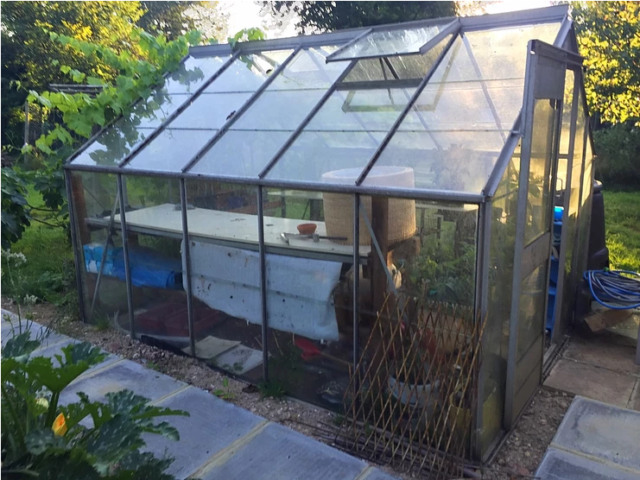
Pete Blunsdon of Root Cause Organics, an experimental microholding in Buckinghamshire, shares the first in a series of guest posts about how he built his very own aquaponics greenhouse and how you can do the same. It’s over to Pete from here…
I first heard about aquaponics at a permaculture talk in London. One of the speakers, Richard Tatum, described the aquaponics installation is his garage. Some months later I had the opportunity to attend a permaculture course at Richard’s home and even got to sample some of his Tilapia on the BBQ!
Aquaponics is the combination of aquaculture (fish farming) and hydroponics (growing plants without soil). Here’s how it works:
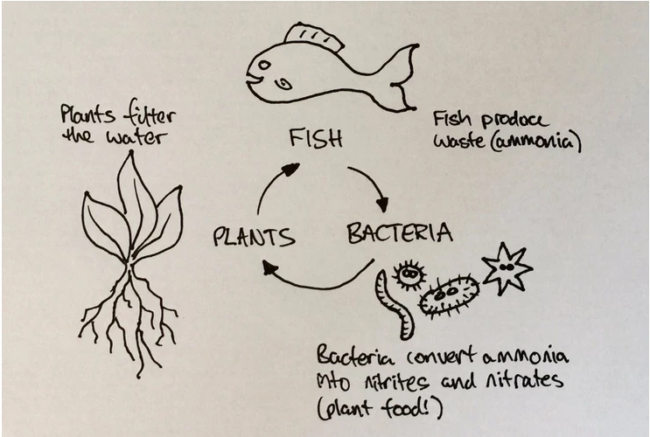
The plants grow in a soil-less growing medium (like gravel) which is periodically flooded and drained with water from the fish tank. Bacteria in the grow beds converts ammonia from the fish waste into nitrites and nitrates which provides the nutrients for the plants. As the water passes through the growing medium it is cleaned before returning to the fish tank.
There’s something very appealing about the concept of aquaponics. It’s a sustainable, closed system that is very economical in its use of water, and uses zero chemical fertilisers. The only inputs are fish food and electricity (to power a pump). The outputs are lots of vegetables and salad crops, and (so long as you leave enough to do their job) a supply of fresh fish!
I learn best by doing, so the plan was to build my own aquaponics system in a small domestic size (10′ x 8′) greenhouse, as pictured at the top of the article.
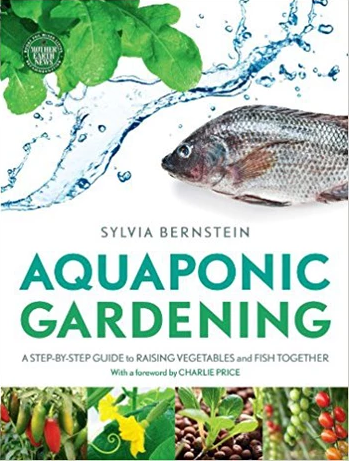
Sylvia Bernstein’s book Aquaponic Gardening provided a good overview and explained some of the common system configurations. I decided on a ‘CHOP2’ system (Constant Height in fish tank, One Pump) as it looked the simplest.
This was my design. The sump tank contains a submerged pump that’s running 24 x 7. The overflow from the fish tank draws water up from the bottom of the tank (to suck up the poo) and feeds into a swirl filter. Note the top of the fish tank overflow is open to avoid creating a siphon that could drain the tank if something went wrong! The swirl filter acts as a separator, trapping the fish poo and feeding clean(ish) water back into the sump. The other branch fed from the pump supplies the grow bed. This gradually fills up until the auto siphon empties it back into the sump. Then it starts to fill again.
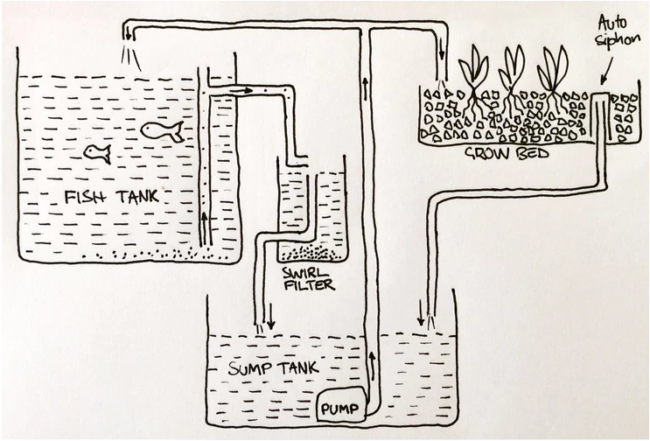
Enough research – let’s get building!
I wanted to base my system on IBCs (Intermediate Bulk Containers) – large plastic containers used to ship liquid products and foodstuffs. They’re cheap and modular and there’s plenty of IBC systems to look at on the web. IBCs typically incorporate a forklift pallet in the base and come in various sizes. I found mine on Gumtree for 25 quid each. They had previously been used for de-ionised water so I knew they’d be safe for the fish.
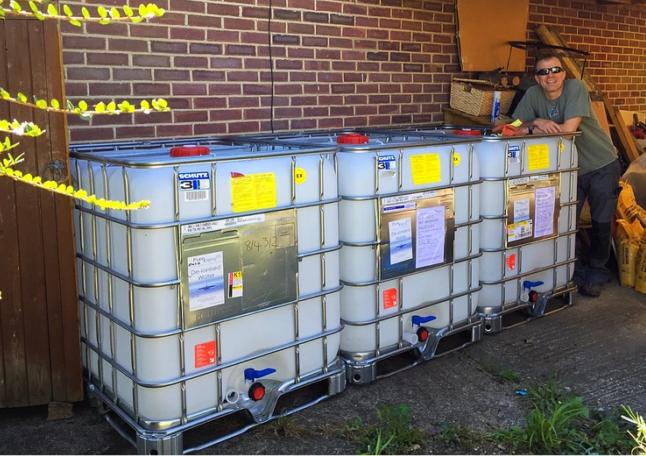
The first job was to cut up the IBCs. One remained whole, but with a hole in the top to access the fish. For the other two I cut the tops off to use as grow beds, and used the remaining two-thirds of a tank as the sump. Cutting them up is pretty easy using an angle grinder with a thin cutting disk for both the metal frames and the plastic tanks.
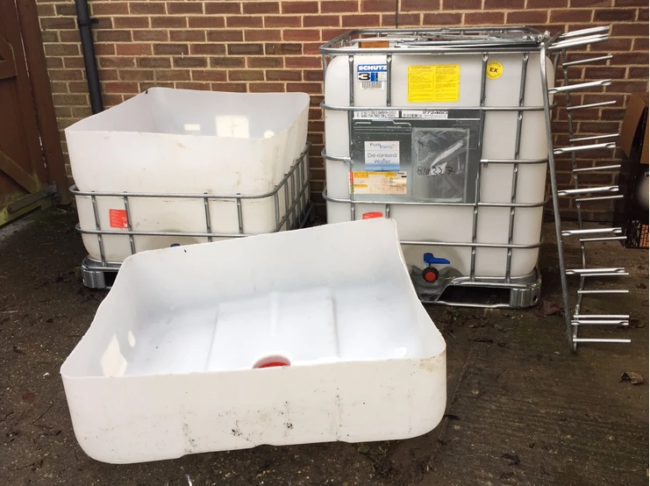
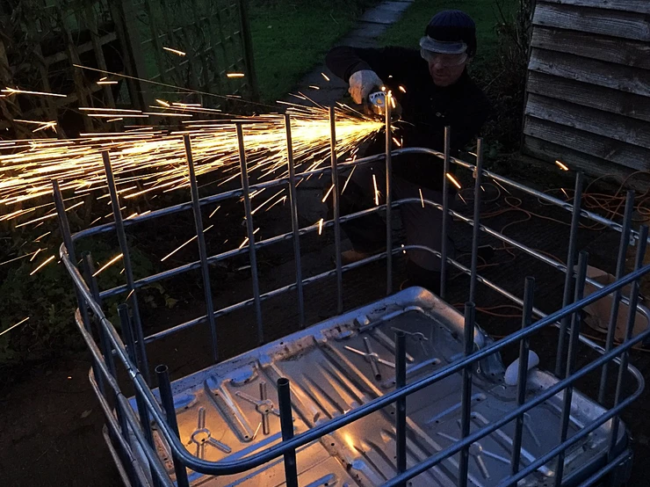
The CHOP2 design uses a pump in a sump tank to supply the fish tank and grow beds, then everything drains via gravity back to the sump. This is pretty simple in terms of plumbing. The main challenge had was how to squeeze two grow beds, a fish tank, and a sump tank into the very limited space of the greenhouse. The solution was to place the sump underneath the grow beds. This meant one thing – digging!
Swinging a pickaxe surrounded by glass is an interesting exercise, but eventually there was a large hole, big enough to bury the sump tank. The grow beds were then supported on a sturdy wooden platform above the sump. The platform has to support around half a tonne so it needs to be strong and well-supported to stop in sinking (I sat mine on concrete pads). The height of the grow beds is a bit of a compromise. It needs to be high enough to make a comfortable working height, but low enough so there’s enough room for plants to grow. And the lower you make it, the deeper the hole for the sump needs to be!
Eventually it was time to install the IBCs – and this meant removing some of the glazing panels.
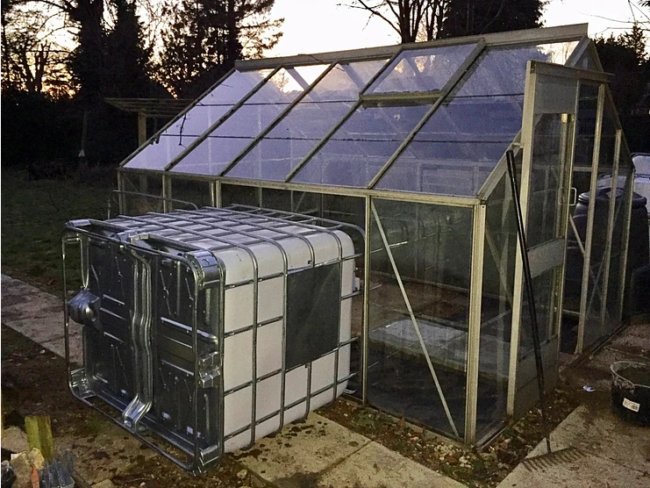
Once everything was in place we were pretty comfortable with the space – there was plenty of room to get to everything and the paving slabs helped keep things relatively clean and tidy.
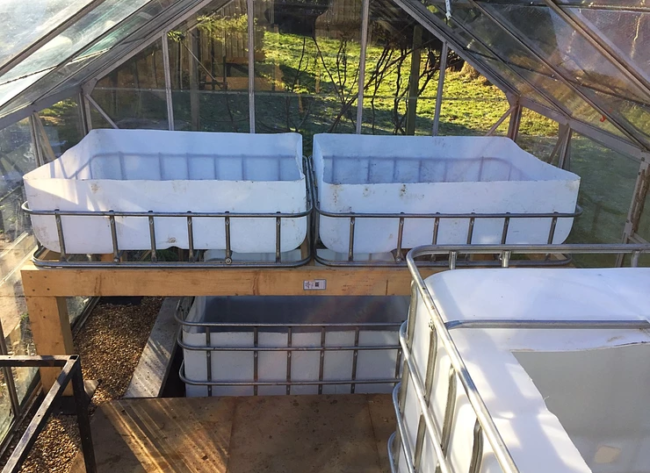
The last step was to add some insulation. Keeping the water warm was going to be a huge challenge so we used ‘space blanket’ loft insulation around and under the sump and to lag the external walls of the fish tank.
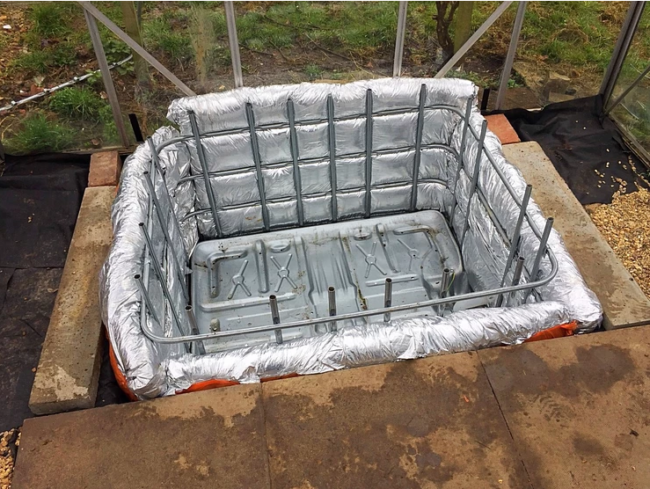
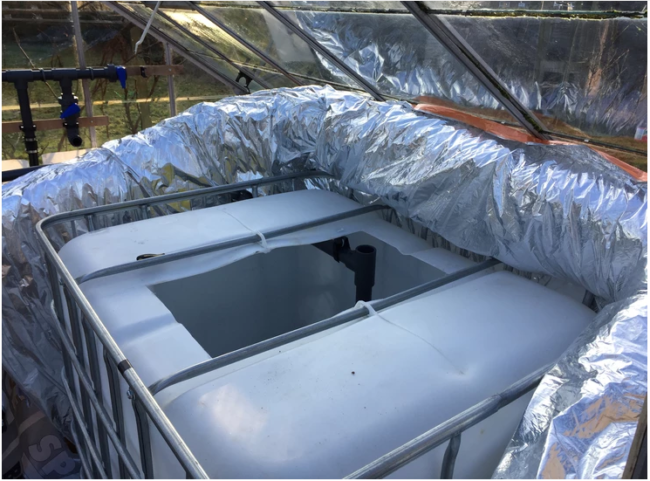
That’s the heavy lifting done. In Part 2 I’ll move on to the next stage – the plumbing!
This article was kindly reproduced with permission from an original post on the Root Cause Organics blog available here.
Pete runs Root Cause Organics, an experimental microholding in Buckinghamshire, alongside Ayesha. Having started out as a scientist and an engineer and despite selling their souls to IT, they haven’t lost their passion for learning and building. Together they aim to save the world, one over-engineered project at a time. You can read more about their work and find a link to their blog here.
The views expressed in our blog are those of the author and not necessarily lowimpact.org's
25 Comments
-
1Andrew Rollinson May 15th, 2018
Sorry for the negativity Dave, but this is ludicrous. Was it initially posted on 1st April?
– It can’t be “sustainable” when the pump is driving the working fluid.
– How much energy does the pump use?
– What will be the payback period for all this equipment based on the initial outlay and cost of running the pump?
– Why insulate the water tanks? What calculations have you done of the fluctuating temperatures that this type of greenhouse experience in the English climate, and how will the fish cope?
– What do you expect for evaporative losses?
– Isn’t the cost of fish food more expensive than the cost of plant food?
– Digging a 1m3 hole in a 6ft greenhouse to bury a water tank!
– There is very little space left to grow crops!
– A wooden frame that needs to support half a tonne?
– All that effort. Why not just grow the plants into the greenhouse soil?
– I also have doubts about the long-term integrity of those plastic-walled tanks when they get in the high summer temperatures of that greenhouse.
I can see why the authors didn’t last as a professional scientist and an engineer.
-
2Dave Darby May 15th, 2018
Andrew – I’ll try to get the author to reply to this.
Remember that we’re an environmental organisation though, and that’s what we’re ultimately concerned about. So if someone wants to go to the effort of doing this, including digging holes as big as they like, that’s just ‘green gym’ as far as we’re concerned.
Insulation, integrity of IBCs, wooden frame etc. – I know that aquaponics is already a thing in this country and elsewhere, and I doubt if people would do it if it didn’t work; but as I say, we’ll try to get the author to respond.
Same with costs / payback – fish can be expensive.
Why not just grow plants? Because he’s getting fish as well, plus the fish provide fertiliser for the plants.
Energy use and embodied energy / materials in the pump – this is the big question.
This small system featured in Permaculture magazine – https://www.permaculture.co.uk/articles/aquaponics-bathtub – uses about £25 of electricity for the pump per year (I’d be surprised if that’s not from a small solar panel). I’m guessing that the output of fish and salad veg is worth a lot more than that.
-
3Pete Blunsdon May 16th, 2018
Thanks for your sharing your perspective Andrew – I’ll try and cover off the points raised.
Dave is right in that aquaponics is a ‘thing’ now and there’s a lot of growth in large scale commercial operations out there. Growup Urban Farms http://growup.org.uk/ is a high tech aquaponics producer in East London serving a high-end market for their microgreens. Bustan Aquaponics http://bustanaquaponics.com/ is the first commercial scale operation in Egypt. Trifecta Ecosystems http://trifectaecosystems.com/ is operating out of Connecticut. There are also hydroponic producers such as Growing Underground http://growing-underground.com/ based in disused tube tunnels in Clapham, and Square Roots https://squarerootsgrow.com/ – a community-centred urban farm in New York growing in shipping containers.
I’m interested in this movement and wanted to learn more about it. Our system is just an experimental ‘lab environment’ to see if this works on a small scale. This isn’t a commercial venture – it’s all about ‘learning by doing’ and having some fun in the back garden along the way. For me, doing something practical like this is much more beneficial than (say) paying for an aquaponics design course. It’s also prompted further related projects – for example solar power, monitoring/control using Arduino/Raspberry Pi etc.
The pump is 22W. It was initially mains powered, but now runs off solar.
The tanks are insulated to try and minimise heat loss through the winter period. This was the biggest challenge and we’ve made use of a wood burner in the coldest months. The large volume of water helps avoid rapid temperature fluctuations that would stress the fish. The tanks are covered to reduce evaporation so we end up topping up every 4-6 weeks.
We do buy in fish food – but then we are rearing fish. Others I know are experimenting with home made vegetable-based fish food, or breeding black soldier fly as food. We’re happy to buy it in for the time being. We do of course get fish to harvest as a result. And lots of fish poo solids which is splendid fertiliser for the garden.
The decision to base this in an pre-existing, unused greenhouse limited the available space and loss of growing space was a worry initially. This has been mitigated by a vertical growing system (growing salad crops in drainpipes) and using the top of the fish tank as a propagation space. So there’s actually minimal loss of growing space.
The cut IBC grow beds have suffered a bit of deformation but are still working fine over a year in. We’ve since learned that it’s best to cut the IBC frames on the sides rather than top/bottom as there’s more support from the metal cage that way.
Effort? Yup, it’s been a lot of hard work, but a fabulous learning experience and loads of fun. Beats blobbing in front of the TV any day and yes, a bit of digging is cheaper than a gym membership.
-
4Andrew Rollinson May 17th, 2018
Thank you Pete.
I have looked at some of those links, and they are distasteful to me in the sense that they proclaim sustainability which they are clearly not. One was actually operating underground using artificial lighting.
I still think that it is a crackpot idea, and that you’d be making better use of your greenhouse space by planting directly into soil, plus saving your £1000+ (or however much more you spent on this), and efforts. Of course you may have money and time in abundance.
Payback would be interesting, and some comparison of how many fish you harvest, plus running costs, lifetime expectancy, and of course the mass of edible plants produced, which in this small space can never feed one person every day, even throughout the summer.
I was initially, and still am perhaps, blunt about this because I think that too many people are deceived by faux sustainability, particularly in the commercial world.
-
5Dave Darby May 17th, 2018
Andrew – are you sure about this? We’re lining up aquaponics as a new topic. Do you think it’s inherently unsustainable (I’m not talking about the underground / artificial lighting option, obviously), and we shouldn’t do it? If so, what are you basing that on?
I don’t think it needs to be anywhere near £1000 for set-up, does it? Some second-hand IBCs, a very small pump and some pipework mainly – assuming you already have a greenhouse. (I have a friend at Redfield community who set up a similar – but smaller, granted- system for nothing at all – using just scrounged and found materials.)
I’ve just scouted round for tilapia prices and it’s coming out anywhere between £7-22 per kilo.
I’ve also scoured around for fish yields from aquaponics, and compiled a few projected or actual yields. They’re usually for bigger systems, granted, so this is just a rough idea. 20,000lbs of fish was quoted for a ¼ acre aquaponics setup. That’s 11k square feet, so divide by 137 for an 80 sq ft greenhouse – that’s 145lbs of fish per year. That’s around 70kg, multiplied by, say, £15 – that’s £1000 of value, just for the fish – then there’s the veg too. I’d say it’s worth it – even if it worked out at half that amount of fish, or less.
Other reasons I thought this might be sustainable:
Most people now live in cities, and this is a way of producing high-protein food in cities, reducing food miles.
Waste from the fish is used to boost plant growth.
The plants can sit above the fish – why is it not a good idea to get a crop of fish as well as veg from the same area?
You can guarantee that it’s organic.
And as Pete says, he sees it as a hobby, so he’s not accounting for his work.
-
6Dave Darby May 17th, 2018
I said this somewhere else, but I think the chance of us avoiding societal collapse are vanishingly slim – the biosphere is haemmorrhaging species and it’s showing no signs of slowing down. If you’re a tinkerer, and you can keep things going, or can provide shelter, energy, food, clothing and maybe even transport for yourself without the corporate infrastrucutre – especially if your soil is heavily degraded or even toxic – then we’re happy to provide that information for people.
-
7Andrew Rollinson May 21st, 2018
I agree with both your last posts Dave.
Am I sure about:
1. Questioning the sustainability claims of those links? “Yes”.
2. This concept in general (not the blog)? I think that it has urban gimmick written all over it. But I think that an objective discussion on the subject from the approach of educating about the history of similar (but not identical) methods – Aztecs growing on floating vegetable gardens – and doing this the “tinkering” way – probably as your friend at Redfield did/does, would be great.
3. Calling this specific approach ludicrous: “Yes”. The author says that it is a “sustainable, closed system”, albeit he adds the caveat that this excludes fish food, pump electricity, and seemingly now wood-fuel heating during the winter. It is also ill-thought out on many engineering and practical levels, as I mentioned.
You quote the cost of fish, but how many can be sustainably harvested from this small tank each year while maintaining the process, and how rapidly does the population recover? Tolerance to such population changes will no doubt be inversely proportional to system size.
I estimated £1000 based on what I read on his blog: the clay beads alone cost £210. I cannot expect that the system will ever achieve payback with this outlay and the O&M costs of pump, fish food, and heating.
Although it may not appear so, I do not want to disparage someone else’s work. But I think that misrepresentation of “sustainability”, and an ignorance of entropy (particularly someone who claims to be an engineer) should be challenged, for in such things (not just aquaponics) the general public is being widely deceived.
From a low impact perspective, I maintain that you will get more space for produce by growing plants directly into the greenhouse soil, with all veg’ waste going into the compost bin to replenish the nutrients lost by harvesting. And, you will waste less energy!
-
8Dave Darby May 21st, 2018
I suppose that if we introduce an aquaponics topic, we’d have to include a lot of caveats, and do a lot more homework. We’d have to talk to people doing it to find what yields to expect, payback times, energy use etc. You’d definitely use more energy doing aquaponics than direct planting, but we’d have to look more carefully at yields vs inputs.
-
9Andrew Rollinson May 22nd, 2018
The principles of such systems are generic, and if one understands them, any caveats are also widely applicable too, and unnecessary.
Aquaponics is replicating a natural system of nutrient cycling, which fundamentally is also one of classical energy and mass cycling (although both of which are actually different names for the same thing, in the non-classic sense). In Nature, the aquaponics system, like almost all on earth, has solar radiation to drive it. This is its necessary energy input: sunlight evaporates water and lifts it up into the atmosphere then brings it back into the system upstream. As it journeys back to where it came from, it brings with it nutrients. Sunlight is also used by the information in plant DNA to store energy in organic chemistry (photosynthesis), which then pass up the food chain. It also warms the system so that all the animal metabolisms can function adequately.
You can replicate such a system in your greenhouse, but you will need to find energy sources for circulating the water, bringing in nutrients for the fish (I think that they are made from petrochemicals now, aren’t they?), and regulating the temperature. It can never be sustainable therefore. On top of this, if you are considering its environmental impact/sustainability, you have to add up all the energy used in producing the materials.
It is folly to just arbitrarily draw a boundary around a system and say that it is sustainable, when you have excluded your fundamental energy inputs by placing them outside that boundary. Any person who claims to be an engineer and makes such a claim is instantly discredited.
It is how perpetual motion claims persisted for hundreds of years. They don’t stand up to scrutiny and the reason is because the boundary has been drawn to exclude the crucial energy input. Unfortunately, the internet is ripe for modern versions of this, and for the unscrupulous who want to attract investors or sell a brand.
Take two children on a see-saw. This appears to be perpetual motion, but it is not. The boundary has been drawn to exclude the food which they have consumed to enable them to keep moving.
These fundamentals of science and engineering should be absolutely clear and emphasised to all children in schools, from an early age. But this knowledge does not suit the corporate world who prefer that mainstream schools are exam-focussed environments which occupy the young with shallow learning. As an example, in this blog here we have two educated people, for whatever reason ignoring these principles.
The importance of al this cannot be stressed enough, in my opinion. Not only is such science interesting knowledge (and I assume that every child is born with a natural curiosity and interest for understanding the world – those who no longer have this have had it sucked out of them) it is absolutely essential to ensure that we can choose how to live efficiently. And, if we choose to ignore the laws of thermodynamics we will never manage resources sustainably and we are doomed.
-
10Dave Darby May 22nd, 2018
Yes, I can’t count the number of times we’ve been approached over the years by people promoting ‘free energy’ devices. I investigated a couple of them, about 20 years ago – but it’s straight in the bin now.
That’s what I mean by caveats – don’t use petrochemical-based fish food; use solar to run the pump; don’t raise fish species that need a wood burner to heat the space etc.
Yes – definitely you’d need to find the embodied energy and materials in the tanks, insulation, pipework, pump and fish food. Plus the greenhouse if it’s new, but I guess that most amateur aquaponicers will already have a greenhouse that they’re converting to aquaponics.
But I don’t think it’s a given that the sums won’t add up. Where’s the evidence for that? I’m not ignoring any principles Andrew – I just want to see some figures. In terms of money, it definitely works. There are commercial aquaponics schemes, and they wouldn’t do it if it lost money. In terms of energy, I don’t know. We’ll have to do some homework – do you know of existing research?
-
11Andrew Rollinson May 23rd, 2018
There are two distinct aspects being mentioned here: 1.Energy efficiency – hence sustainability and low impact living, and 2. Profitability.
I think that I have shown how this engineered version cannot be sustainable, and stated the fundamentals which apply to any attempt at engineering such a contraption. Maybe I haven’t explained it adequately. I know that you understand entropy, so I don’t know why you are still unsure “in terms of energy”.
Profitability, or “In terms of money”, of course it can be profitable. But this is a different matter. Would they be profitable without playing the “green”, “sustainable”, “renewable” card, and promoting it to young urbanites? I very much doubt it, although fads come and go.
A question: Would a high earning office worker in London be likely to buy a fish or a lettuce if it was sold as being cheap because it had been spawned in a cellar, grown throughout its adult life in artificial light, in a system which was totally dependent on grid electricity 24 hours per day?
I don’t have any research to cite on aquaponics. I actually didn’t know about its popularity until this blog. There may be some, but in my experience research on the truth about energy efficiency in modern literature is scant, for corporate interests have pervaded acadaemia too and the culture has shifted as a consequence. There are pockets of resistance, and here is one not completely unrelated research publication, which shows how most commercial anaerobic digesters (currently promoted as renewable technologies by both govts and industries and used to attract ethical investors) actually operate with negative efficiency – more electricity needed to heat up and stir the tank than is actually produced in the biogas:
http://www.aidic.it/cet/14/38/076.pdf
-
12Dave Darby May 23rd, 2018
I’ve got a couple of problems with what you’re saying.
First, you definitely haven’t shown how this particular aquaponics system can’t be sustainable. You’ve only given your opinion that it isn’t, but no figures to show that energy in is more than energy out.
Second, what on earth is wrong with selling to young urbanites?
I agree about lettuce/fish spawned in cellars, grown with artificial light, in a system dependent on grid electricity 24/7. But that’s not the system in the article.
Interesting about the anaerobic digesters, but as with aquaponics (and most things), it’s a question of scale. We made a little anaerobic digester at Redfield – with the usual compost, in oil drums with a neoprene cover, gas collected in a couple of old plastic drums via a bit of pipework. We had all the materials lying around already. A bit of fun really, but we boiled a kettle for a cup of tea every day from it, so saved electricity, and got the same compost at the end.
-
13Dave Darby May 23rd, 2018
I believe that there are hundreds of thousands of little digesters on family farms in India too.
-
14Andrew Rollinson May 23rd, 2018
Anaerobic digesters: Absolutely, on the small scale they are a low impact method of converting we organic matter into biogas. You misunderstand my point. I am very “pro” these systems. I have also seen many of them in India running on cow dung. These are old, simple, and based on good design. My reference was about large commercial systems that heat and stir the tanks. On the evidence in the research article, are you saying that it too is erroneous?
Young urbanites: Nothing is wrong with them. I didn’t say that there was.
Energy, and positive or negative efficiency: I feel that I have explained here, and if you cannot see it, then I do not have the capacity to explain any better. It is fundamental thermodynamics. Perhaps we should go about it a different way. Perhaps you could show me how any system can operate in a way where there can be more “energy out than energy in”?
-
15Dave Darby May 24th, 2018
Come on Andrew. I think I’m making sense here. You haven’t explained, you’ve just opined. To explain, you’d need to show how fish (and veg) produced this way is somehow worse than eating fish / veg from supermarkets, which is where most people get them. And to do that, you’d need to provide some figures, which we don’t have – certainly about fish yields. Is the calorific value of the fish produced worth the inputs? We don’t know.
‘The best is the enemy of the good.’ is what applies here, I think. For example, we have electric vehicles as one of our topics, but looked at independently, they’re a terrible idea, and not sustainable at all. They’re made of metals, which have to be mined; they require millions of acres to be asphalted; they require lots of electricity in their manufacture and use; batteries are a nightmare – etc. But if the world’s fleet was electric rather than internal combustion, would that be a good thing? I think it would. Would it be even better if we got rid of cars altogether? Yes – but that’ s not going to happen.
Is the aquaponic system in the article, in principle, sustainable or not? We can’t know, can we, because we don’t know how many fish / veg he’s going to get from it. Fish is energy-intensive. It either requires fishing boats, trucks and supermarkets, or at least a car journey to the sea to catch them yourself. I can’t see that this system is going to use more energy to produce the same amount of fish protein – but it depends on the fish harvested. And we don’t have that figure, so we don’t know. We’d have to ask people who’ve been doing it on a small-scale for a while.
He’s using second-hand kit, a 22W pump with a solar panel, he’ll use solid waste from the fish as a fertiliser for the garden, and the liquid waste from the fish will fertilise the plants in the greenhouse. He’s also looking at growing his own fish food.
Now the wood burner, that’s another thing altogether. I agree that this is completely unsustainable (unless he moves into the greenhouse), and that in the UK, species that don’t need heating should be kept, not tilapia.
If aquaponics is going to be a Lowimpact topic, it’s only going to be about small-scale production. All our topics are about the small-scale. But I’ll have to do some homework to find out whether it can be sustainable on the small-scale (and I’m not saying that the research on large-scale anaerobic digestion is erroneous, no).
[Young urbanites. You said: ‘Profitability, or “In terms of money”, of course it can be profitable. But this is a different matter. Would they be profitable without playing the “green”, “sustainable”, “renewable” card, and promoting it to young urbanites? I very much doubt it, although fads come and go.’ And my respsonse is: ‘what’s wrong with playing the green card and promoting to young urbanites?’]
-
16Dave Darby May 24th, 2018
This kind of thing is precisely what a low-impact journal would be for, btw. But a major question would be whether technologies are sustainable in an absolute sense, or whether they’re more sustainable than what exists already. If they’re not absolutely sustainable, then obviously they can’t be sustained for any length of time without causing ourselves damage. But if they’re more sustainable than what exists already, then they can buy us time.
And there’s another element. For example, if it could be shown that obtaining a certain amount of power from a nuclear power station is more sustainable than obtaining the same amount from solar panels on a million roofs, then the ‘greater good’ might still not be served by switching to nuclear. There’s another factor to take into consideration that most people miss. This corporate, growth-oriented system we live in is the root cause of ecological damage, imho. Nuclear power is not ‘convivial’ – i.e. it can’t be owned by individuals or communities – only by the corporate sector or the state. If we’re going to break this system and put humanity on a path that doesn’t lead to ecological collapse, then we have to take power away from the corporate sector, and that’s only possible with convivial tech.
-
17Andrew Rollinson May 25th, 2018
No, no, no! This is NOT what a Low Impact journal would be for. One cannot “opine” on the laws of thermodynamics. To directly answer your question: “Is the aquaponic system in the article sustainable or not?” NO. It is not. It can never be. It is ludicrous engineering and should be considered absolutely “out of court”. You are on dangerous ground here Dave.
May I suggest that you type in “perpetual motion” to the internet and see what it says (sorry for being condescending). This is my evidence. I have nothing more to add to what I have said already. It is futile. If you cannot see it, may I refer you to something that you said elsewhere in a blog very near to this one. Here you “opine” (sorry) on why a capitalist couldn’t see what you see. Your conclusions:
“◦they’re scared of what happened in the 20th century [with planned economies] – in which case I share their concerns;
◦they have a vested financial interest in this system – certainly the UK has many people who fit that description;
◦they’re really unimaginative;
◦they don’t understand the question.”
I sincerely hope that you don’t understand the question. I have formed this opinion by the way that you are now subjectively asking whether the aquaponics system is better or worse. So far you have said “…In terms of energy…, …In terms of money,…, [and] is [it] somehow worse”. All the other information to digest about electric cars and nuclear power seems again to show a clear lack of clarity about what answer you are actually seeking. I think you will find as you look into the subject further that such is the nature of everyone who ponders on and tries to unpick perpetual motion claims.
Topics on energy and thermodynamics are desperately needed on this website, for they underpin everything.
I agree with you on cars and nuclear power by the way.
-
18Dave Darby May 25th, 2018
You’ve misunderstood me. I’m not saying that a low-impact journal would be based on opinions. I’m saying the exact opposite – that it would be based on careful analysis of data (and you haven’t delivered that here).
An aquaponics system isn’t a perpetual motion device. If I set up a system to grow cold water fish and veg, using second-hand kit and a 22W pump with a solar panel, do you think that the concept is inherently unsustainbable, before you know what the yields are? If so, why? Or are you saying that you know already that the yields won’t justify the input?
You need some kit to produce food. Are all fishing boats inherently unsustainable? Tractors? Greenhouses? Can only hunter-gatherer societies be sustainable (I’m not saying that this isn’t the case). But where do you draw the line and why? (I’m also not saying that you’re wrong about aquaponics, I just need to understand why a tractor can be sustainable, but some pipework, a pump and a couple of old IBCs can’t). Or, to put it another way – why is a small aquaponics set-up (inherently) like a perpetual motion machine, but a small gasification plant isn’t?
I don’t understand the connection with the capitalism article.
I agree that we could do with more input from energy specialists – i.e. from you, if a) you’re right and b) I understand what you’re saying, exactly.
-
19Dave Darby May 25th, 2018
Andrew – I’m a generalist. If I focus on one thing it’s political philosophy. But my work puts me in the company of specialists – in finance, in blockchain, in construction, in planning, in co-operative law, in coding and IT – especially free and open source software, etc. I need the help of those specialists. You are a specialist in energy and engineering. If you know how aquaponics can’t be sustainable, I need you to tell me how you know that. Please don’t assume that I know anywhere near as much as you in your subject. I need you to tell me, and anyone else reading this who is not a specialist in energy and engineering, in layman’s terms.
I want to have these discussions in public, because I think they’re important. I think that specialists often assume greater knowledge of their subject in the mainstream than actually exists (now there’s a blog article).
-
20Andrew Rollinson May 30th, 2018
I can state with confidence that it is unsustainable because of its reliance on electric power, fish food, and some method of regulating the water temperature. This is due to the laws of thermodynamics. It is not an opinion.
A “low(er) impact” version of this system could be built, seemingly like your friend has done at Redfield, but it would still need pump power, fish food and probably water temperature regulation. It would not be sustainable. I’d be interested in reading about it though.
The choice of location – in a greenhouse – would probably be the worst possible because temperatures in these small structures can go from zero to 40C in a few hours.
This, and everything else that I have said aside, how can the solar (electric pump-replacement) option be satisfactory? The clay beads will not have moisture retentive properties like soil and so for half the day (on average) the growth media will be dry and the plants will be under extreme stress. I suppose that the next thing will be to add a battery bank, which incurs extra cost and efficiency losses.
In addition, the tomatoes won’t grow well (at all) in this media as they are gross feeders; and the need to use plug plants and then wash off as much soil as possible is both laborious, costly (if bought), and likely to kill some of the seedlings in the process.
Even if one could harvest lots of fish, there will still be the need for the pump and the fish food. In fact, since the fish get nothing from the plants, all you are doing here is aquaculture – keeping fish and buying fish food to fatten them up, in conditions which are essentially battery farming because to reduce pump size (and therefore running costs) it is most economical to have as many fish as possible in as small a volume of water as possible. But, I don’t think that it will be feasible to harvest many fish, if any at all – the tank is too small. Without the fish, what have you got? An expensive and complex way of growing plants.
-
21Andrew Rollinson May 30th, 2018
A biomass gasifer is sustainable because it is completely detached from any input of electricity or natural gas or coal. It is fed with wood scraps (so it is not, however a perpetual motion machine! Such a thing is impossible) and generates its own internal heat. This is called an “autothermal” process. Some of the waste wood is sacrificed inside to generate heat to keep the process going. Of course it is only sustainable when there a local source of waste forestry or agricultural residue, but since this is waste anyway and would rot away (probably to methane), the gasifier is a low impact, self-sufficient, sustainable option.
Aquaponics cannot work without a pump to power the system, fish food, and temperature regulation (requires energy).
-
22Dave Darby May 30th, 2018
You say that it’s not sustainable because it requires the input of electricity / fossil fuels. So does boatbuilding, oil refining, and the catching, freezing, delivering and collection of fish to and from a supermarket. We’d have to compare the amount of electricity used per kg of fish produced in both systems before we knew which method is more sustainable. Do you have those figures? And we also have to take into consideration the damage that trawlers cause to sea beds, the reduction in wild fish populations, the dolphins that get caught in fishing nets, and the fish that is thrown back. None of those things happen in aquaponics. Plus the fact that in aquaponics there’s a plant crop (and fertiliser) too, which would have to be taken into consideration for a true comparison; and finally, temperature control may not be as important if raising fish from more northerly climes.
Or should we not eat fish at all? If not, we’ll have to replace fish protein with something else – so what will that be, and would it be more sustainable?
I’m not so much interested in this particular system as I am about aquaponics generally, but even for this system, I’d need to see some figures to compare. It’s proof I’m after – i.e. figures to compare methods.
Another example: electric vehicles also require the input of electricity. But electric vehicles are more sustainable overall than internal combustion vehicles – at least if the electricity is generated from renewables (and some would argue nuclear – although I’m not sure I would). I could show you research that suggests this, although maybe I don’t need to – maybe you agree that electric vehicles are better. But one method will be more sustainable than the other, and that’s the method we should use – other than to ban driving. I’m not saying that humans wouldn’t be better off without cars, because overall, I think they would – but from where we are now, there would have to be a lot of cultural and infrastructural change before that was achievable without unacceptable force.
-
23dilgreen May 30th, 2018
I don’t know a great deal about aquaponics, and I’m no expert on thermodynamics, but I have a couple of points that might be of interest.
First, energy budgets.
Energy budget thinking is always about where we draw the boundary of the system. Only systems which get ‘free’ energy from outside the boundary can maintain and increase complexity. In these terms, the ecosystem of the planet can only be considered sustainable based on ‘free’ energy from the sun (plus internal geothermal processes). Without accounting for this ‘free’ energy, life on this planet looks like a pretty good advert for a perpetual motion (perpetual expansion!) machine, having gone from some process that presumably originated within a cubic micron or two in some ocean thermal vent 3.5 billion years ago, to a system which extends roughly 40km up and down from the planetary surface.
Where you draw your boundary is as much about the scope of the conversation as it is about reality. It is important in such conversations, therefore, to make sure that everyone is happy with the scope under discussion. It is always possible to say; “Yes well, but if you draw the boundary a little wider, you can see that this is not at all sustainable…”.
Second, heat sources.
A few years ago I got rather excited about the absolutely enormous amounts of waste heat being produced in large data centres. This doesn’t mean that data centres are bad – but it does mean that far from being ‘free’, our internet use (like posting and viewing here) has measurable energy costs, which adds up to a large contribution to global warming (up to 2% of world emissions and rising – roughly equivalent to aviation: https://ec.europa.eu/jrc/en/publication/trends-data-centre-energy-consumption-under-european-code-conduct-data-centre-energy-efficiency).
If we used the internet as much as we do and relied on individual servers, things would probably be worse – largely because they would be much less efficient. Bunching them up in huge buildings makes it worth investing in very sophisticated tech to reduce energy and other consumption. One of Deep Mind’s early projects with Google was to develop AI controls for the cooling in data centres, which achieved large improvements (https://deepmind.com/blog/deepmind-ai-reduces-google-data-centre-cooling-bill-40/).
Nevertheless, it remains the case that data centres use enormous amounts of energy – roughly half of which is expended on keeping the machines cool enough to work properly – essentially on fancy air-conditioning.
Although that last sentence seems sensible, in fact what is happening is that almost all the energy is being used in the servers, but that half of it just ends up making them hot, and only half to send pictures of cute kittens to Auchtermuchty. A relatively small fraction of the total energy is then spent pumping that heat (either as hot air or hot water) to the outside of the building and then using evaporative cooling to get rid of it into the atmosphere – a type of direct global warming.
And Data Centres are just the most obvious examples of the numerous sources of low-grade waste heat that industrial civilisation churns out without thinking about it.
So when I got excited about this, I started looking into ways in which we might use this heat rather than throwing it away (usually damaging microclimates as we go – and quite often increasing other people’s cooling bills to boot – temperatures in cities are often 4º higher than in rural areas, some of which is due to warm air from refrigeration and air-conditioning plant).
Unfortunately, there is a problem with low-grade heat, which is that in order to get heat energy to do anything really useful (such as generate electricity), you need a relatively large temperature difference between your heat input and your exhaust (this is essentially about the efficiency with which any extraction of work can happen – https://en.wikipedia.org/wiki/Carnot_cycle). And low grade heat doesn’t provide this (typically only 10 or 20ºC above the ambient temperature).
This means that even though the *amount* of energy in low-grade heat might be large, the work that you can extract from it is limited. Essentially, this limits you to finding applications where boosting the temperature to a few degrees above ambient is some use. Direct heat transfer from one medium to another is not ‘work’ in the technical sense, so this can be more effective, although doing extra work (fans, pumps and the like) can make it faster.
I came up with three options for using reliable supplies of waste heat on a year round basis – swimming pools, aquaponics and microbial production.
And of these, aquaponics seems much more useful – in that you can feed people and fertilise plants, as opposed to just swimming in warmer water (a large data centre can dump 1MW in a year – enough to warm an olympic size swimming pool).
In terms of the points that have been made above, what this allows us to do is to draw the envelope of energy considerations to encompass a wider zone. If we were to integrate an aquaponics setup with any reasonably large cooling system heat rejection plant, we begin to be able to consider the aquaponics either as using ‘free’ energy – in that it was going to be ‘wasted’ in any case – or, more holistically, if we include the cooled system, to consider that the useful energetic outputs of the aquaponic setup (calories in fish and plants) can offset (account for) some of the energy usage of the cooling plant.
I don’t know that much about microbial production, but it is clear that many microbes have significantly higher productivity at warmer temperatures (hence the worries about legionella bacteria and cooling plant!). So here again, we might find that we can produce fish food using some microbial product using the same waste heat to good effect (possibly even extracting even more heat from the waste water after the aquaponics tanks have been heated).
Third, scale.
Each time I come to Low Impact, I seem to end up talking about scale and productivity, and suggesting that we need to think about doing things at the appropriate scale – which often will not be small-scale.
As I said above, the environmental impact of the internet would likely be much greater if it were not based on concentrated servers. If we are to use the internet, it seems likely that we will have data centres for some time to come, chucking out enormous amounts of low-grade heat (put a hand round the back of your laptop).
Rather than backyard aquaponics lash-ups (valuable as these will undoubtedly be in developing techniques and capacities), we should probably be thinking about large scale semi-industrial versions. That said, while I don’t believe that air-conditioned office buildings are worth saving, the idea of frozen food seems entirely justifiable on all sorts of grounds – and in urban areas, supermarket sized shops are also probably demonstrably more efficient than small shops (I know, I know…) – and if you put these together, you get relatively small heat rejection on a per-supermarket basis. These operate all year round, churning out energy. Fish and bacteria can both eat waste food… Perhaps an integrated aquaponics design that could be sited on the roof of a supermarket would be worth thinking about?
-
24Dave Darby May 31st, 2018
What a fantastic idea. We already use heated swimming pools – mostly heated via fossil fuels and nuclear (probably), so if possible, we may as well try to locate future swimming pools and data centres next to each other. Might work for aquaponics too – increase yields and replace fossil fuels instead of just wasting it / heating the atmosphere.
On size – I know what you mean, but there’s another aspect – conviviality, as Ivan Illich called it. Large-scale things tend to become impersonal and ultimately corporate, especially if there’s a crisis. Look what happened to the Co-op Bank, whilst hundreds of local credit unions remained unscathed. The Co-op itself might go the same way, and recently the Midcounties Co-op has taken over the Phone Co-op I believe. So it remains co-operative, but it could have gone the other way.
OK, one more aspect. As institutions grow in size, many of the jobs in them become specialised and incredibly boring – shelf-stacking, telesales, sitting at a till etc. If we want interesting lives, maybe our work needs to be embedded in communities, at a small-enough scale to provide lots of different kinds of work, and lots of interaction with local people. It’s what so many people crave, I think.
-
25Dick Moriarty June 17th, 2018
I’m really pleased that you have given this a go – since my degree project some 30 years ago was to produce a sustainable aquaponics system and I proved that it could work.My fish were fed some of the green waste from the veg and worms that were produced from a wormery sustained by the remaining green waste which included duck weed that was used to shelter the water and reduce evaporation. I used koi which were originally kept in Japan as a food source rather than being decorative and my system used a flood and drain watering system that worked off a very small solar powered pump. I’m thinking of resurrecting my project to sustain my bonsai and some fruit – I don’t eat fish but they are a great source of nutrient for the plants. As a pond keeper I have used vegetative filtering to stabilise the water for the fish which all works brilliantly. Don’t go off opinions when the system really works – just do it





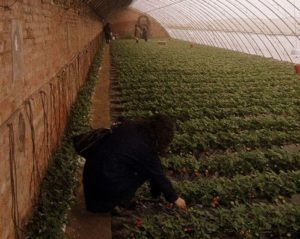 A tale of two greenhouses: in praise of the solar greenhouse
A tale of two greenhouses: in praise of the solar greenhouse
 A matter of scale: how small farms provide more jobs and more food per acre
A matter of scale: how small farms provide more jobs and more food per acre
 How hydroponics could be integrated into restaurants, bars, schools and hospitals
How hydroponics could be integrated into restaurants, bars, schools and hospitals
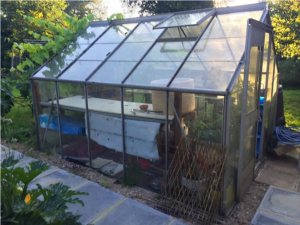 How to build your own aquaponics greenhouse (Part 2)
How to build your own aquaponics greenhouse (Part 2)
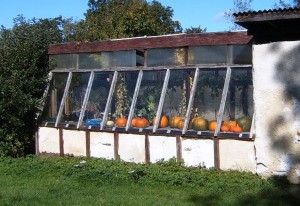 Greenhouses & polytunnels
Greenhouses & polytunnels
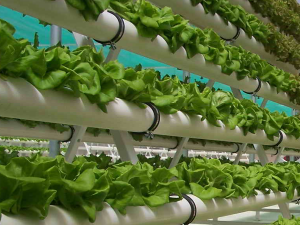 Hydroponics
Hydroponics
 Smallholding
Smallholding
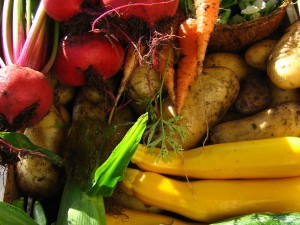 Vegetable growing
Vegetable growing


